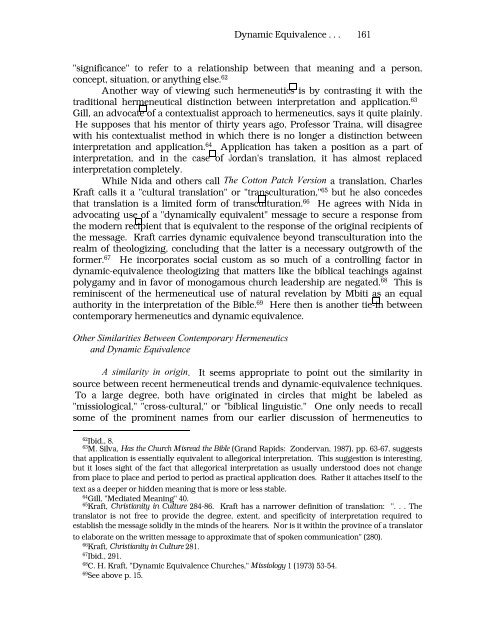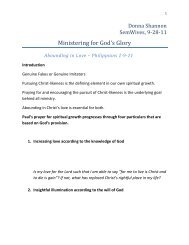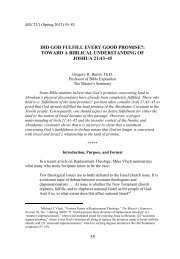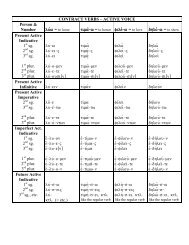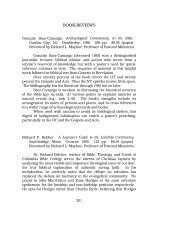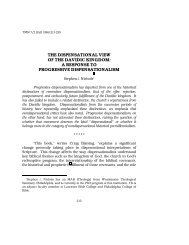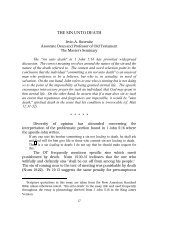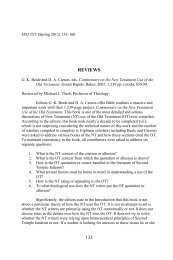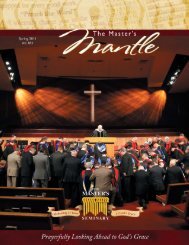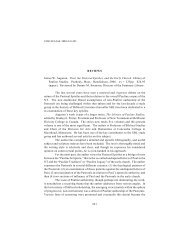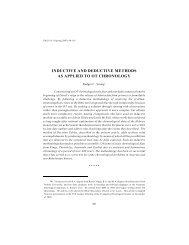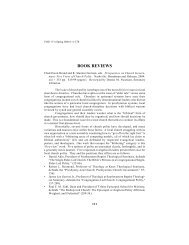dynamic equivalence: a method of translation or a system
dynamic equivalence: a method of translation or a system
dynamic equivalence: a method of translation or a system
- No tags were found...
You also want an ePaper? Increase the reach of your titles
YUMPU automatically turns print PDFs into web optimized ePapers that Google loves.
Dynamic Equivalence . . . 161"significance" to refer to a relationship between that meaning and a person,concept, situation, <strong>or</strong> anything else. 62Another way <strong>of</strong> viewing such hermeneutics is by contrasting it with thetraditional hermeneutical distinction between interpretation and application. 63Gill, an advocate <strong>of</strong> a contextualist approach to hermeneutics, says it quite plainly.He supposes that his ment<strong>or</strong> <strong>of</strong> thirty years ago, Pr<strong>of</strong>ess<strong>or</strong> Traina, will disagreewith his contextualist <strong>method</strong> in which there is no longer a distinction betweeninterpretation and application. 64 Application has taken a position as a part <strong>of</strong>interpretation, and in the case <strong>of</strong> J<strong>or</strong>dan's <strong>translation</strong>, it has almost replacedinterpretation completely.While Nida and others call The Cotton Patch Version a <strong>translation</strong>, CharlesKraft calls it a "cultural <strong>translation</strong>" <strong>or</strong> "transculturation," 65 but he also concedesthat <strong>translation</strong> is a limited f<strong>or</strong>m <strong>of</strong> transculturation. 66 He agrees with Nida inadvocating use <strong>of</strong> a "<strong>dynamic</strong>ally equivalent" message to secure a response fromthe modern recipient that is equivalent to the response <strong>of</strong> the <strong>or</strong>iginal recipients <strong>of</strong>the message. Kraft carries <strong>dynamic</strong> <strong>equivalence</strong> beyond transculturation into therealm <strong>of</strong> theologizing, concluding that the latter is a necessary outgrowth <strong>of</strong> thef<strong>or</strong>mer. 67 He inc<strong>or</strong>p<strong>or</strong>ates social custom as so much <strong>of</strong> a controlling fact<strong>or</strong> in<strong>dynamic</strong>-<strong>equivalence</strong> theologizing that matters like the biblical teachings againstpolygamy and in fav<strong>or</strong> <strong>of</strong> monogamous church leadership are negated. 68 This isreminiscent <strong>of</strong> the hermeneutical use <strong>of</strong> natural revelation by Mbiti as an equalauth<strong>or</strong>ity in the interpretation <strong>of</strong> the Bible. 69 Here then is another tie-in betweencontemp<strong>or</strong>ary hermeneutics and <strong>dynamic</strong> <strong>equivalence</strong>.Other Similarities Between Contemp<strong>or</strong>ary Hermeneuticsand Dynamic EquivalenceA similarity in <strong>or</strong>igin. It seems appropriate to point out the similarity insource between recent hermeneutical trends and <strong>dynamic</strong>-<strong>equivalence</strong> techniques.To a large degree, both have <strong>or</strong>iginated in circles that might be labeled as"missiological," "cross-cultural," <strong>or</strong> "biblical linguistic." One only needs to recallsome <strong>of</strong> the prominent names from our earlier discussion <strong>of</strong> hermeneutics to62Ibid., 8.63M. Silva, Has the Church Misread the Bible (Grand Rapids: Zondervan, 1987), pp. 63-67, suggeststhat application is essentially equivalent to alleg<strong>or</strong>ical interpretation. This suggestion is interesting,but it loses sight <strong>of</strong> the fact that alleg<strong>or</strong>ical interpretation as usually understood does not changefrom place to place and period to period as practical application does. Rather it attaches itself to thetext as a deeper <strong>or</strong> hidden meaning that is m<strong>or</strong>e <strong>or</strong> less stable.64Gill, "Mediated Meaning" 40.65Kraft, Christianity in Culture 284-86. Kraft has a narrower definition <strong>of</strong> <strong>translation</strong>: ". . . Thetranslat<strong>or</strong> is not free to provide the degree, extent, and specificity <strong>of</strong> interpretation required toestablish the message solidly in the minds <strong>of</strong> the hearers. N<strong>or</strong> is it within the province <strong>of</strong> a translat<strong>or</strong>to elab<strong>or</strong>ate on the written message to approximate that <strong>of</strong> spoken communication" (280).66Kraft, Christianity in Culture 281.67Ibid., 291.68C. H. Kraft, "Dynamic Equivalence Churches," Missiology 1 (1973) 53-54.69See above p. 15.


